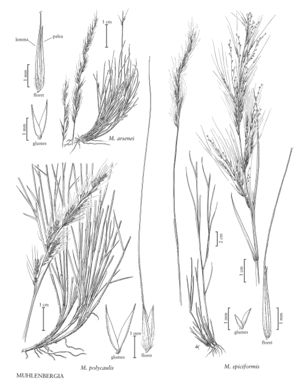Difference between revisions of "Muhlenbergia spiciformis"
imported>Volume Importer |
imported>Volume Importer |
||
| Line 43: | Line 43: | ||
|publication year= | |publication year= | ||
|special status= | |special status= | ||
| − | |source xml=https:// | + | |source xml=https://bitbucket.org/aafc-mbb/fna-data-curation/src/2e0870ddd59836b60bcf96646a41e87ea5a5943a/coarse_grained_fna_xml/V25/V25_737.xml |
|subfamily=Poaceae subfam. Chloridoideae | |subfamily=Poaceae subfam. Chloridoideae | ||
|tribe=Poaceae tribe Cynodonteae | |tribe=Poaceae tribe Cynodonteae | ||
Revision as of 21:04, 5 November 2020
Plants perennial; cespitose, not rhizomatous. Culms 25-80 cm, erect, wiry; internodes mostly glabrous, strigose or glabrous below the nodes. Sheaths scabridulous, not becoming spirally coiled when old; ligules 1-3 mm, membranous, acuminate, deeply lacerate; blades 2-12 cm long, 1-3 mm wide, flat to involute, scabridulous abaxially, hirtellous or scabrous adaxially. Panicles 4-18(20) cm long, 0.2-2.8 cm wide, contracted, not dense, sometimes interrupted below; panicle branches 0.6-5 cm, appressed or diverging up to 30° from the rachises, spikelet-bearing to the base; pedicels 0.1-3 mm. Spikelets 3-4 mm. Glumes unequal, 0.3-1 mm, shorter than the florets, 1-veined, unawned; lower glumes shorter than the upper glumes, obtuse to acute, sometimes erose; lemmas 2.8-4 mm, narrowly lanceolate, purplish, scabrous, sparsely appressed-pubescent on the calluses and lower 1/4 of the midveins and margins, hairs shorter than 0.3 mm, apices acuminate, awned, awns (10)20-40 mm; paleas 2.6-3.9 mm, narrowly lanceolate, intercostal region sparsely pubescent on the basal 1/3, apices acuminate, scabrous; anthers 0.9-1.6 mm, purplish. Caryopses 2-2.6 mm, fusiform, brownish. 2n = 40.
Discussion
Muhlenbergia spiciformis grows on rocky slopes, cliffs, and calcareous rock outcrops, often in thorn-scrub and open woodland communities. Its elevational range is 450-2800 m; its geographic range extends from the southwestern United States to northern Mexico.
Selected References
None.
